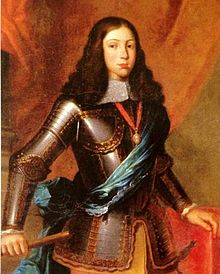King of Portugal from 1656 to 1683 From Wikipedia, the free encyclopedia
Dom Afonso VI (Portuguese pronunciation: [ɐˈfõsu]; 21 August 1643 – 12 September 1683), known as "the Victorious" (o Vitorioso), was the second king of Portugal of the House of Braganza from 1656 until his death.[1] He was initially under the regency of his mother, Luisa de Guzmán, until 1662, when he removed her to a convent and took power with the help of his favourite, D. Luís de Vasconcelos e Sousa, 3rd Count of Castelo Melhor.[2]
| Afonso VI | |
|---|---|
 Portrait in the National Coach Museum | |
| King of Portugal | |
| Reign | 6 November 1656 – 12 September 1683 |
| Acclamation | 15 November 1657 |
| Predecessor | John IV |
| Successor | Peter II |
| Regents | Luisa de Guzmán (1656–1662) Peter, Duke of Beja (1668–1683) |
| Chief minister | Count of Castelo Melhor (1662–1667) |
| Born | 21 August 1643 Ribeira Palace, Lisbon, Portugal |
| Died | 12 September 1683 (aged 40) Sintra Palace, Sintra, Portugal |
| Burial | |
| Spouse | |
| House | Braganza |
| Father | John IV of Portugal |
| Mother | Luisa de Guzmán |
| Religion | Roman Catholicism |
Afonso's reign saw the end of the Restoration War (1640–68) and Spain's recognition of Portugal's independence.[3] He also negotiated a French alliance through his marriage.[4] In 1668, his brother Pedro II conspired to have him declared incapable of ruling, and took supreme de facto power as regent, although nominally Afonso was still sovereign.[5] Queen Maria Francisca, Afonso's wife, received an annulment and subsequently married Pedro.[6] Afonso spent the rest of his life and reign practically a prisoner.[5][7][8]
Afonso was the second of three sons born to King John IV and Queen Luisa.[9] At the age of three, he experienced an illness that resulted in paralysis on the right side of his body.[10][11] The condition was believed to have also affected his intellectual abilities.[10][12] His father created him 10th Duke of Braganza.[13]
After the death of his eldest brother Teodósio, Prince of Brazil in 1653, Afonso became the heir apparent to the throne of the kingdom.[10] He also received the crown-princely title 2nd Prince of Brazil.

He succeeded his father, John IV, in 1656 at the age of thirteen.[11] His mother, Luisa de Guzmán, was named regent in his father's will.[11][14]
Luisa's regency continued even after Afonso came of age because he was considered mentally unfit for governing.[15][16] In addition to lacking intellect, the king exhibited wild and disruptive behavior.[11][10] In 1662, after Afonso terrorized Lisbon at night alongside his favorites,[17][18] Luisa and her council responded by banishing some of the king's companions that were associated with the raids.[18] Angered, Afonso took power with the help of Castelo Melhor and Luisa's regency came to an end.[19][20][21] She subsequently retired to a convent,[22][14] where she died in 1666.[23]
Afonso appointed Castelo Melhor as his private secretary (escrivão da puridade).[24][19] He proved to be a competent minister.[20] His astute military organization and sensible general appointments resulted in decisive military victories over the Spanish[25] at Elvas (14 January 1659), Ameixial (8 June 1663) and Montes Claros (17 June 1665),[26][27] culminating in the final Spanish recognition of sovereignty of Portugal's new ruling dynasty, the House of Braganza,[28][29] on 13 February 1668 in the Treaty of Lisbon.[30][31]
Colonial affairs saw the Dutch conquest of Jaffna, Portugal's last colony in Portuguese Ceylon (1658),[32] and the cession of Bombay and Tangier to England (23 June 1661) as dowry for Afonso's sister, Infanta Catherine of Braganza, who had married King Charles II of England.[33][34]
Melhor successfully arranged for Afonso to marry Maria Francisca of Savoy,[35] a relative of the Duke of Savoy, in 1666,[36] but the marriage was short-lived. Maria Francisca filed for an annulment in 1667 based on the impotence of the king.[37][38] The church granted her the annulment, and she married Afonso's brother, Peter II, Duke of Beja.[6][39]

Also in 1667, Pedro managed to gain enough support to force Afonso to relinquish control of the government to him,[38] and he became prince regent in 1668.[37][6][36] While Pedro never formally usurped the throne, Afonso was king in name only for the rest of his life.[40][41] For seven years after Peter's coup, Afonso was kept on the island of Terceira[42] in the Azores.[29][43] His health broken by this captivity, he was eventually permitted to return to the Portuguese mainland, but he remained powerless and kept under guard. At Sintra he died in 1683.[42][44][45]
The room where he was imprisoned is preserved at Sintra National Palace.
| Ancestors of Afonso VI of Portugal |
|---|
Seamless Wikipedia browsing. On steroids.